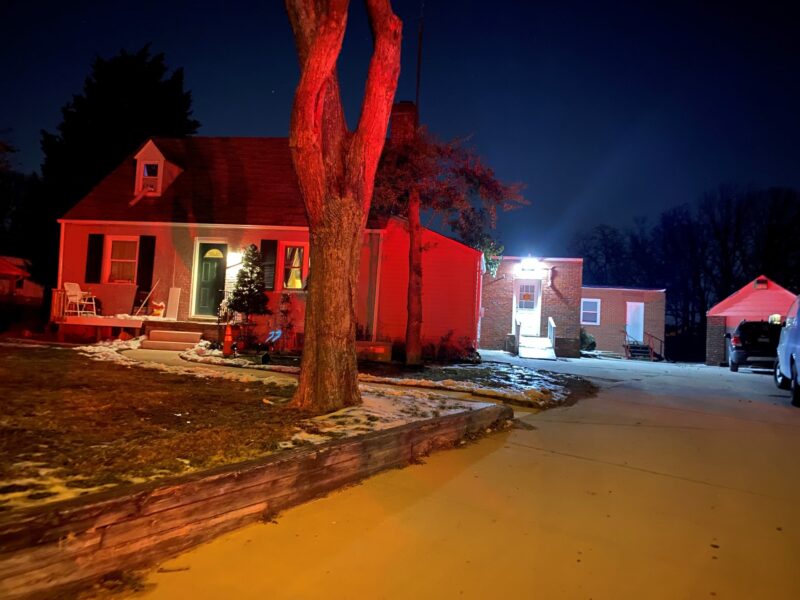 On Sunday, February 21, at approximately 12:09 a.m., units from Prince George’s County Fire/EMS Department and Montgomery County Fire & Rescue Service were dispatched to a house in the 2700 block of Hughes Road in a residential area of Adelphi for a report of multiple unconscious people.
On Sunday, February 21, at approximately 12:09 a.m., units from Prince George’s County Fire/EMS Department and Montgomery County Fire & Rescue Service were dispatched to a house in the 2700 block of Hughes Road in a residential area of Adelphi for a report of multiple unconscious people.
Upon arrival, crews located two buildings which were attached to the rear of the house and determined the actual physical address of the incident was the 3000 block of Buck Lodge Road. Inside one of the rear buildings, where a church worship service was being held, crews located 25 to 30 people several of whom were presenting with symptoms of carbon monoxide poisoning (vomiting, headache, dizziness). All of the occupants were conscious.
Crews immediately evacuated the building. Multiple occupants either refused medical treatment or left the scene. EMS units transported a total of 7 adult patients in stable condition to area hospitals for evaluation and treatment.
On Monday, February 22, four additional patients self-reported to an area hospital suffering from dizziness and vomiting. If anyone who was present at the location and is feeling ill, please seek medical attention immediately.
Initial carbon monoxide (CO) readings inside the affected building were above normal indicating a build-up of CO inside the building. Crews noted there were several gas-powered wall heaters inside the enclosed space. The source of the hazardous level of carbon monoxide is under investigation.
Crews ventilated the building. Incident supervisors requested utility workers to respond to the scene and a natural gas leak was also discovered in a crawl space so the gas main was shut off.
The buildings were deemed uninhabitable by the Prince George’s County Fire/EMS Department. The Prince George’s County Department of Permitting, Inspections and Enforcement (DPIE) will coordinate with the Office of the Fire Marshal on the investigation which is ongoing.
Carbon monoxide poisoning occurs when carbon monoxide builds up in your bloodstream and can lead to serious tissue damage and even death. Improperly ventilated appliances and engines, especially in a tightly sealed or enclosed space, may allow carbon monoxide to accumulate to dangerous levels.
Carbon monoxide (CO) is known as the “silent killer” because it is colorless, odorless, and tasteless. It is impossible to detect without monitoring equipment. A working CO alarm is the most effective tool residents can use to detect the presence of carbon monoxide. CO alarms can be purchased at hardware and home improvement stores. CO alarms should be installed in a central location outside each sleeping area, on every level of the home, and in other locations where needed.
CARBON MONOXIDE (CO) POISONING SAFETY TIPS:
- • Install at least one battery-powered or hard-wired CO detector on each level of your home and near sleeping areas, and make sure it is more than 5 feet from fuel-burning appliances to prevent false alarms.
- • Ensure that fuel-burning appliances are properly installed and working according to the manufacturer’s instructions. Inspect these appliances for adequate ventilation.
- • Do not burn charcoal inside your house, even in the fireplace.
- • Do not use gasoline-powered generators inside of your house.
- • Keep chimneys clear of animal nests, leaves and residue to ensure proper venting.
- • Do not block or seal shut exhaust flues or ducts for appliances, such as water heaters, ranges and clothes dryers.
IF YOUR CARBON MONOXIDE (CO) ALARM SOUNDS:
- Never ignore your CO detector, if it sounds.
- Operate test/reset button.
- Determine if anyone in the household is experiencing symptoms of CO poisoning such as a headache, nausea, drowsiness or confusion. Call 911.
- Open doors and windows and exit your home. Leave the CO alarm where it is.
- If you have an alarm with digital display, emergency responders can determine the highest level of CO present and decide how to treat victims.
- Do not return to your home until the emergency personnel have arrived, the home is aired out and your CO alarm returns to normal operation.
Health effects and symptoms from Carbon Monoxide (CO) are based on the different levels and length of exposure as well as the patients age and health condition. The concentration of CO is measured in parts per million (ppm). The exposure of CO in the range from 1 to 70 ppm are uncertain but most people will not experience any noticeable symptoms. As the level of CO rises, and remains above 70 ppm, symptoms become more noticeable and patients may have headaches, fatigue, and nausea. As CO levels increase even more to above 150 to 200 ppm, the concentration can become deadly if its persistent and patients will have disorientation, unconsciousness, or even death.
All photos courtesy of the Official Prince George’s County Fire/EMS Department Page



